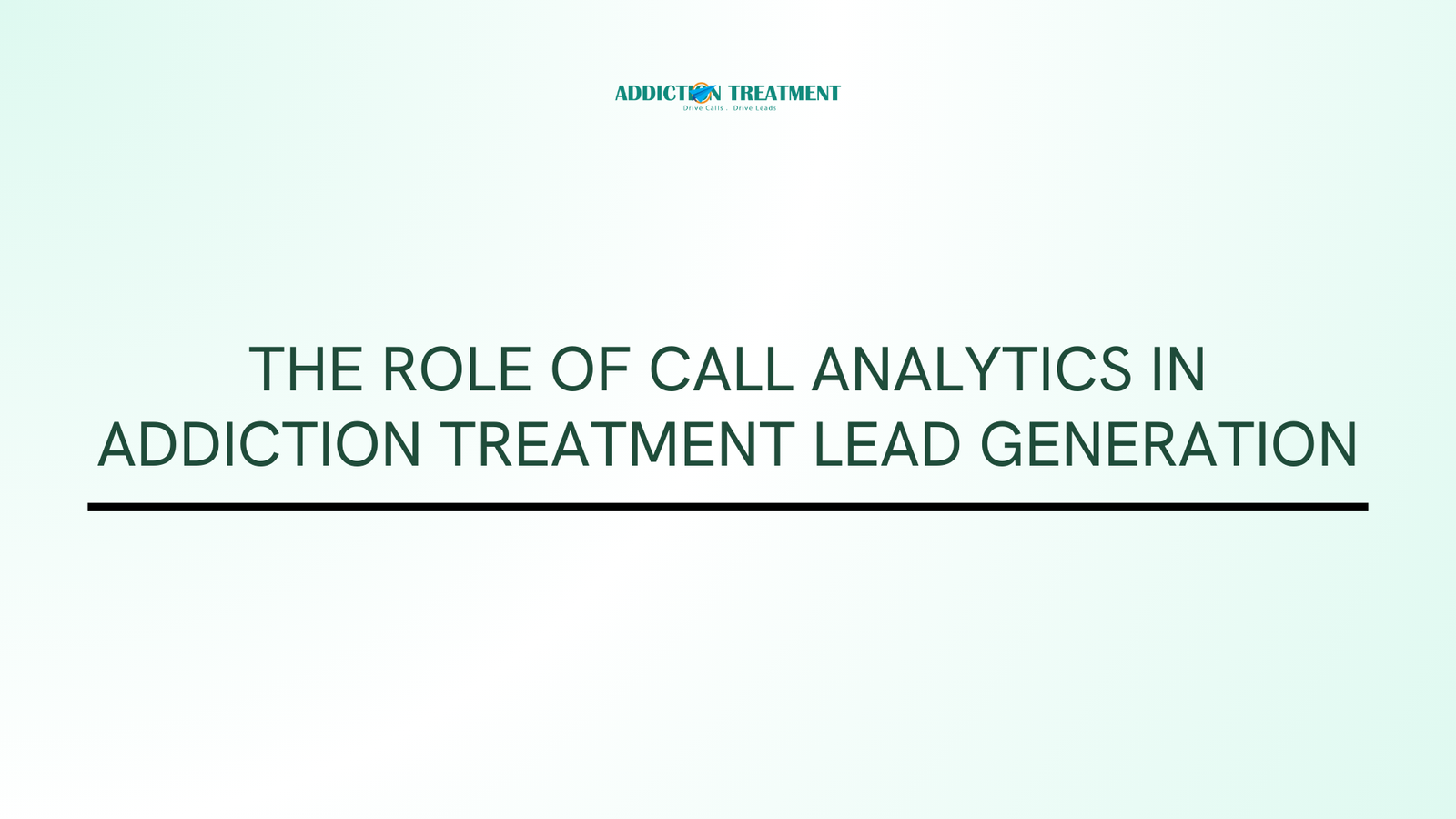Addiction treatment centers rely on effective lead generation strategies to connect with individuals seeking help. Among the tools that have proven transformative in this field, call analytics stands out as a game-changer. By analyzing call data, addiction treatment centers can gain insights into their marketing performance, improve lead quality, and optimize the patient intake process. This article explores how call analytics can revolutionize lead generation for addiction treatment centers, highlighting actionable strategies to maximize its potential.
What Is Call Analytics?
Call analytics involves tracking, analyzing, and reporting data from phone calls to gain insights into customer behavior, marketing campaign effectiveness, and team performance. For addiction treatment centers, these insights are invaluable in understanding how callers interact with your organization and identifying opportunities to enhance lead generation efforts.
Why Call Analytics Is Crucial for Addiction Treatment Lead Generation
1. Understanding Lead Sources
Call analytics can track where your leads are coming from, whether it’s a Google ad, social media campaign, or a referral website. This helps you:
- Identify High-Performing Channels: Focus resources on campaigns driving the most calls.
- Optimize Underperforming Channels: Adjust strategies for campaigns generating fewer leads.
2. Improving Call Quality
Analyzing call recordings and data helps you understand the quality of your leads and identify trends in patient inquiries.
- Caller Intent: Determine if callers are seeking immediate help or simply gathering information.
- Lead Qualification: Assess whether callers meet the criteria for admission, such as insurance coverage or readiness for treatment.
3. Enhancing Caller Experience
Understanding common pain points and questions can help you refine your approach to inbound calls, improving the overall patient experience.
- Reduce Call Drop-Off Rates: Address factors causing callers to abandon calls, such as long wait times.
- Streamline Conversations: Use insights to provide faster and more accurate responses to common queries.
Key Benefits of Call Analytics for Addiction Treatment Centers
1. Optimized Marketing Campaigns
Call analytics provides real-time data on which marketing campaigns are driving the most calls. This allows you to:
- Allocate Budgets Wisely: Invest in high-performing campaigns and channels.
- A/B Test Effectively: Compare the performance of different ads or landing pages to determine what resonates best with your audience.
2. Increased Lead Conversion Rates
By analyzing call data, you can identify and address gaps in your intake process, leading to higher conversion rates.
- Personalized Follow-Ups: Use data to tailor follow-ups based on the caller’s needs and preferences.
- Prioritize High-Quality Leads: Focus on leads more likely to convert into admissions.
3. Improved Team Performance
Call analytics allows you to evaluate how well your intake team handles calls, offering opportunities for training and improvement.
- Monitor Call Handling Skills: Identify areas where team members excel or need additional training.
- Set Performance Benchmarks: Use data to establish and track performance metrics for your team.
Key Features of Call Analytics for Lead Generation
1. Call Tracking
Track the source of every inbound call to understand which marketing channels are driving leads.
- Keyword-Level Tracking: Identify which keywords generate the most calls in your PPC campaigns.
- Multi-Channel Attribution: Attribute calls to specific campaigns, ads, or content pieces for a holistic view of performance.
2. Call Recording and Transcription
Call recordings and transcriptions provide valuable insights into caller behavior and team interactions.
- Analyze Caller Intent: Understand the primary reasons people contact your center.
- Identify Common Questions: Spot recurring inquiries to improve scripts and training.
3. Real-Time Analytics Dashboards
A centralized dashboard displays metrics like call volume, duration, and conversion rates, helping you make data-driven decisions.
- Monitor Trends: Observe patterns in call activity over time to adjust strategies accordingly.
- Track ROI: Assess the return on investment for each marketing channel based on call performance.
4. Integration with CRM
Integrating call analytics with your customer relationship management (CRM) system streamlines lead tracking and follow-ups.
- Automated Lead Scoring: Assign scores to leads based on call data to prioritize follow-ups.
- Centralized Data: Access complete lead profiles, including call history and notes, in one place.
How to Implement Call Analytics in Addiction Treatment Lead Generation
1. Choose the Right Tools
Select a call analytics platform that meets your specific needs. Popular options include CallRail, Ringba, and Twilio.
- Scalability: Ensure the platform can handle your call volume as your campaigns grow.
- Custom Features: Look for features like call transcription, keyword tracking, and CRM integration.
2. Set Clear Goals
Define what you want to achieve with call analytics, such as increasing conversion rates, reducing missed calls, or identifying high-performing campaigns.
3. Train Your Team
Provide your intake team with training on how to use call analytics tools and interpret the data.
- Script Optimization: Use insights to create effective call scripts.
- Performance Feedback: Regularly review analytics to provide constructive feedback to your team.
4. Analyze and Act on Insights
Regularly review call analytics data to identify trends and opportunities for improvement.
- Optimize Marketing Strategies: Adjust campaigns based on call performance data.
Refine the Intake Process: Use data to address inefficiencies in how calls are handled.
Measuring Success with Call Analytics
Track the following metrics to evaluate the impact of call analytics on your lead generation efforts:
- Call Volume: Monitor the number of calls generated by each marketing channel.
- Conversion Rate: Measure how many calls result in successful admissions.
- Average Call Duration: Longer calls often indicate higher engagement and interest.
- Missed Call Rate: Aim to minimize the number of calls that go unanswered.
Overcoming Challenges in Call Analytics
1. Data Overload
With so much data available, it can be overwhelming to determine what’s most important. Focus on actionable metrics that directly impact your goals, such as conversion rates and lead sources.
2. Privacy Concerns
Handling sensitive data requires adherence to privacy regulations like HIPAA. Ensure your call analytics tools are compliant and secure.
3. Team Buy-In
Some team members may resist changes in processes. Address this by demonstrating the benefits of call analytics and involving them in implementation decisions.
Future Trends in Call Analytics
As technology evolves, call analytics is becoming more advanced and integrated:
- AI and Machine Learning: AI-powered tools can provide deeper insights into caller behavior and predict lead outcomes.
- Speech Analytics: Advanced speech recognition technology can analyze tone, sentiment, and intent during calls.
- Real-Time Coaching: AI can offer live feedback to agents during calls, improving performance in real time.
Conclusion
Call analytics is an essential tool for addiction treatment centers looking to optimize lead generation efforts. By providing insights into lead sources, team performance, and caller behavior, call analytics empowers organizations to make data-driven decisions that improve conversion rates and enhance patient experiences. With the right tools and strategies in place, your center can effectively connect with those in need and drive meaningful growth.


Leave a Reply